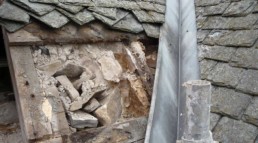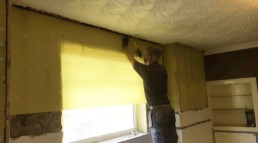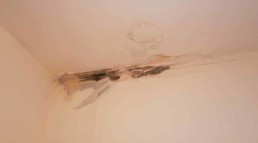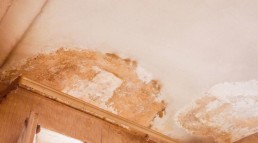Learn What is Penetrating Damp
It is often difficult to understand where or how a property develops a damp problem. Another issue is then identifying the appropriate treatment as there are multiple variables depending on the cause of penetrating damp and the condition of the property.
Penetrating damp often manifests itself by damp on walls or ceiling and if untreated can be incredibly damaging to a property as it can affect structural timbers and cause them to rot.
We have put together this guide to demonstrate what exactly penetrating damp is, what causes it and how to treat the problem quickly and effectively.
Penetrating Damp
Penetrating damp, also known as lateral damp, is the absorption of water through the external envelope of the property. All facets of a building can be affected by dampness, including roofs, ceilings, walls and floors. The problem occurs when a property defect allows damp to penetrate the property and affect the internal fabric.
This particular type of damp is often found in older properties with solid walls, but new buildings also suffer from dampness penetration due to defective pointing or render damaged roof or rainwater goods or even defective cavity wall insulation.
Penetrating damp is different to rising damp. Rising damp moves up a wall from the ground due to capillary action and only reaches a certain height. Penetrating damp is much more dangerous because it can happen at any point and ingress into a property at any height.

What Causes Penetrating Damp?
There are numerous reasons why damp can enter your property. Old or defective masonry, missing or damaged roof tiles, incorrectly sealed windows and doors are just some of the common causes for penetrating damp.
Some bricks are surprisingly porous and can absorb an incredible amount of water. If there is no problem, then water held within the bricks should evaporate in dry weather. However, any defects in the brickwork, even hairline cracks, can allow water to collect and move further inside and eventually penetrate the interior walls of the building.
Cast-iron rainwater pipes are another common cause of penetrating damp. Visibility to the back of the piping is difficult and tricky to access. Painting behind the pipework is often neglected because of this and will lead to rusting. Eventually the rusted piping will start leaking onto the wall and cause heavy saturation of the masonry. It is at this point that penetrating damp is likely to occur.

Which Areas Can Get Affected by Penetrating Damp?
Check the roof of your property. Look for missing or cracked tiles, including the roof ridge tiles (the tiles at the very top of the roof) and the flashing (where the roof meets a wall or chimney). If anything is missing or loose, this will need to be fixed immediately to prevent penetrating damp.
As part of the check of the roof, closely inspect guttering for any major blockages or holes, particularly if the guttering is cast iron, as this can quickly rust if not maintained property. Next, check any downpipes on the property. Rainwater that does not drain away properly could be running down the outside wall which will absorb quickly into the brickwork or stonework.
Windows and doors are other common areas affected by penetrating damp. If they are installed incorrectly, or if the waterproof seal has degraded or is defective then this is a potential area for penetrating damp.
Cavity walls are just as susceptible as outer walls. Most homes are constructed with two walls with a cavity in between. This is to help moisture evaporate before it reaches the section of interior wall. A window or pipework may interrupt the cavity, and if waterproof sealing around these sections becomes degraded it can act as a bridge for moisture, allowing it to travel across to the interior wall. Also, if the cavity has been filled with insulation this may become damp and transmit moisture into the property.
How to Identify Penetrating Damp?
There are plenty of signs that you should look out for if you suspect you have a penetrating damp issue.
Exterior walls might have an obvious damp patch with moss and algae growing on the brickwork, stonework or render– a common symptom of penetrating damp. Moisture entering the masonry will spread and dry with the rise and fall of outside temperature and level of rainwater. This will damage brickwork and mortar, so if you see an area of the exterior brickwork that does not look in great shape, this could be another sign of penetrating damp.
Inside the property, you might notice a damp, musty smell in a particular room. Also note if you have trouble heating the room. Is it always cold, even when the heating is on? This is another sign that you could have a damp issue resulting in cold spots.
Also be on the lookout for damaged plaster, paintwork or rotted skirting and flooring boards. Another obvious sign is watermarks; these may often grow when there is a particularly heavy downfall of rain. There also may be signs of black mould growth caused by condensation forming on the cold wall area affected by dampness.
Penetrating Damp Treatment
If you suspect you have a penetrating damp issue, the first thing to do is make a note of the potential problem areas. It is unwise to attempt to fix all the problems yourself as having damp proofing issues might have caused further structural problems such as dry and wet rot within timber structures of your property.
Preventative maintenance is always the best way to avoid major damage from damp issues. Ensure you regularly check and clear guttering and downpipes. Survey the roof coverings, rainwater goods, pointing, masonry and render around your property and if necessary, get damaged areas repaired. Remember to also check the seals around windows and doors for any degraded material. If you find it hard completing the task yourself, then do not hesitate to contact a PCA accredited property preservation specialist such as Richardson & Starling.



